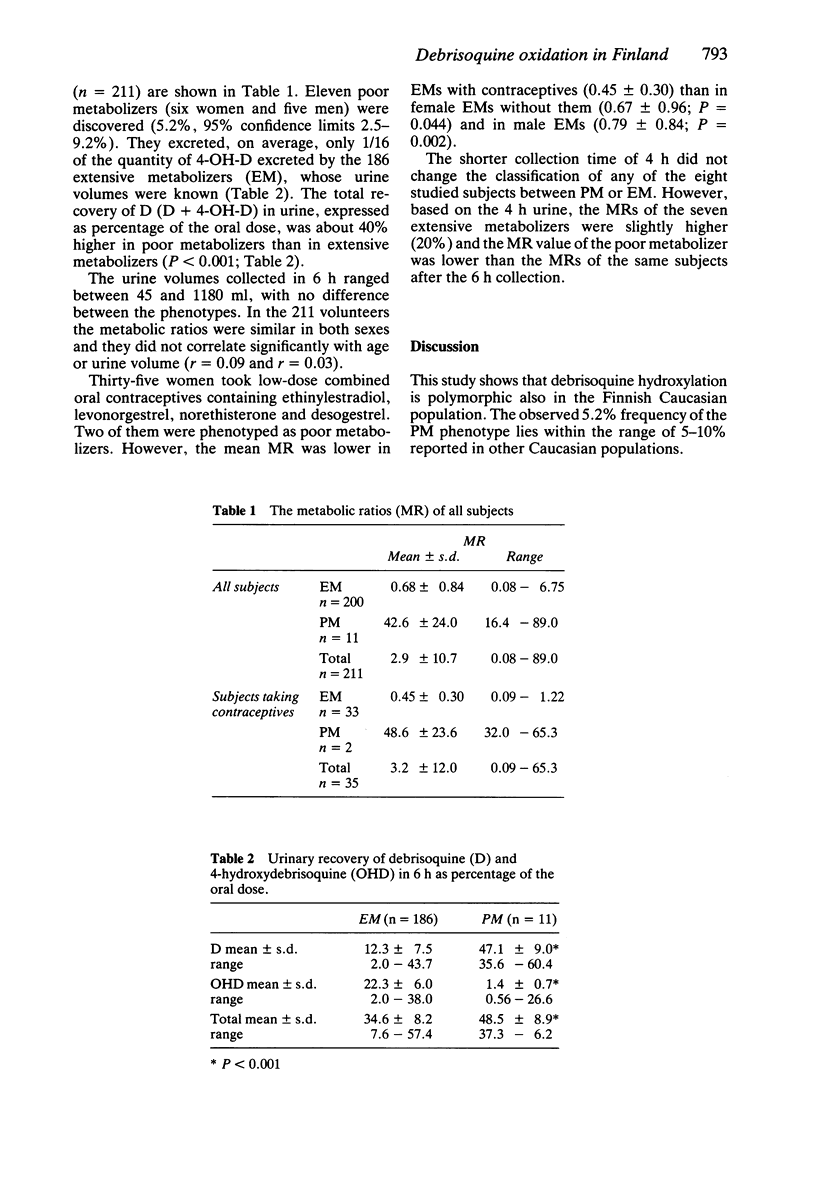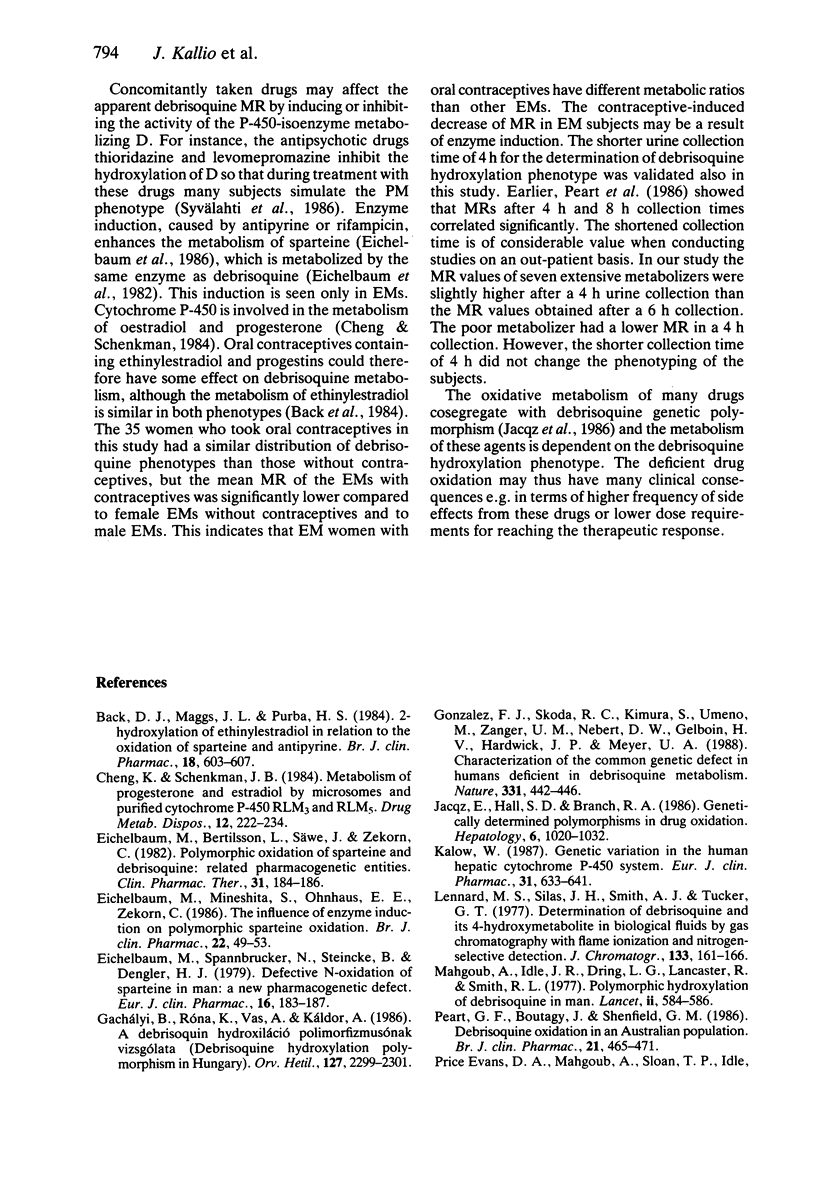Abstract
1. The debrisoquine hydroxylation phenotype was assessed in 211 healthy subjects of Finnish Caucasian origin. 2. A bimodal distribution was observed in the urinary debrisoquine/4-hydroxydebrisoquin ratio. Eleven subjects (about 5%) were poor metabolizers of debrisoquine, when a ratio of 12.6 was used as the cut-off point. 3. The mean metabolic ratio of 35 extensive metabolizers taking oral contraceptives was slightly lower than that of extensive metabolizers not taking contraceptives. This indicates that oral contraceptives may change the phenotyping near the metabolic ratio of 12.6. 4. The metabolic ratios were determined in eight subjects using both 4 h and 6 h urine collection times. The metabolic ratios corresponded well with each other indicating the usefulness of the shorter 4 h collection time.
Full text
PDF




Selected References
These references are in PubMed. This may not be the complete list of references from this article.
- Back D. J., Maggs J. L., Purba H. S., Newby S., Park B. K. 2-Hydroxylation of ethinyloestradiol in relation to the oxidation of sparteine and antipyrine. Br J Clin Pharmacol. 1984 Oct;18(4):603–607. doi: 10.1111/j.1365-2125.1984.tb02511.x. [DOI] [PMC free article] [PubMed] [Google Scholar]
- Cheng K. C., Schenkman J. B. Metabolism of progesterone and estradiol by microsomes and purified cytochrome P-450 RLM3 and RLM5. Drug Metab Dispos. 1984 Mar-Apr;12(2):222–234. [PubMed] [Google Scholar]
- Eichelbaum M., Bertilsson L., Säwe J., Zekorn C. Polymorphic oxidation of sparteine and debrisoquine: related pharmacogenetic entities. Clin Pharmacol Ther. 1982 Feb;31(2):184–186. doi: 10.1038/clpt.1982.29. [DOI] [PubMed] [Google Scholar]
- Eichelbaum M., Mineshita S., Ohnhaus E. E., Zekorn C. The influence of enzyme induction on polymorphic sparteine oxidation. Br J Clin Pharmacol. 1986 Jul;22(1):49–53. doi: 10.1111/j.1365-2125.1986.tb02879.x. [DOI] [PMC free article] [PubMed] [Google Scholar]
- Eichelbaum M., Spannbrucker N., Steincke B., Dengler H. J. Defective N-oxidation of sparteine in man: a new pharmacogenetic defect. Eur J Clin Pharmacol. 1979 Sep;16(3):183–187. doi: 10.1007/BF00562059. [DOI] [PubMed] [Google Scholar]
- Evans D. A., Mahgoub A., Sloan T. P., Idle J. R., Smith R. L. A family and population study of the genetic polymorphism of debrisoquine oxidation in a white British population. J Med Genet. 1980 Apr;17(2):102–105. doi: 10.1136/jmg.17.2.102. [DOI] [PMC free article] [PubMed] [Google Scholar]
- Gonzalez F. J., Skoda R. C., Kimura S., Umeno M., Zanger U. M., Nebert D. W., Gelboin H. V., Hardwick J. P., Meyer U. A. Characterization of the common genetic defect in humans deficient in debrisoquine metabolism. Nature. 1988 Feb 4;331(6155):442–446. doi: 10.1038/331442a0. [DOI] [PubMed] [Google Scholar]
- Jacqz E., Hall S. D., Branch R. A. Genetically determined polymorphisms in drug oxidation. Hepatology. 1986 Sep-Oct;6(5):1020–1032. doi: 10.1002/hep.1840060534. [DOI] [PubMed] [Google Scholar]
- Kalow W. Genetic variation in the human hepatic cytochrome P-450 system. Eur J Clin Pharmacol. 1987;31(6):633–641. doi: 10.1007/BF00541288. [DOI] [PubMed] [Google Scholar]
- Lennard M. S., Silas J. H., Smith A. J., Tucker G. T. Determination of debrisoquine and its 4-hydroxy metabolite in biological fluids by gas chromatography with flame-ionization and nitrogen-selective detection. J Chromatogr. 1977 Mar 11;133(1):161–166. doi: 10.1016/s0021-9673(00)89216-x. [DOI] [PubMed] [Google Scholar]
- Mahgoub A., Idle J. R., Dring L. G., Lancaster R., Smith R. L. Polymorphic hydroxylation of Debrisoquine in man. Lancet. 1977 Sep 17;2(8038):584–586. doi: 10.1016/s0140-6736(77)91430-1. [DOI] [PubMed] [Google Scholar]
- Peart G. F., Boutagy J., Shenfield G. M. Debrisoquine oxidation in an Australian population. Br J Clin Pharmacol. 1986 May;21(5):465–471. doi: 10.1111/j.1365-2125.1986.tb02827.x. [DOI] [PMC free article] [PubMed] [Google Scholar]
- Silas J. H., Lennard M. S., Tucker G. T., Smith A. J., Malcolm S. L., Marten T. R. The disposition of debrisoquine in hypertensive patients. Br J Clin Pharmacol. 1978 Jan;5(1):27–34. doi: 10.1111/j.1365-2125.1978.tb01594.x. [DOI] [PMC free article] [PubMed] [Google Scholar]
- Syvälahti E. K., Lindberg R., Kallio J., De Vocht M. Inhibitory effects of neuroleptics on debrisoquine oxidation in man. Br J Clin Pharmacol. 1986 Jul;22(1):89–92. [PMC free article] [PubMed] [Google Scholar]
- Tucker G. T., Silas J. H., Iyun A. O., Lennard M. S., Smith A. J. Polymorphic hydroxylation of debrisoquine. Lancet. 1977 Oct 1;2(8040):718–718. doi: 10.1016/s0140-6736(77)90527-x. [DOI] [PubMed] [Google Scholar]


